2020 Update: This post is now eight years old and still as popular as ever! I am still using Cascade Professional / Fryer Boil Out to this day with great success. Go read the Amazon reviews of this fantastic product!
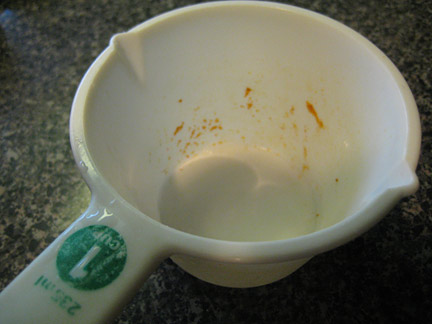
Is your dishwasher not getting your dishes as clean as it used to? If it isn’t, you might be surprised to learn that your dishwasher may be fine — the actual problem could be with your detergent. Back in 2010, many states enacted a ban on phosphates in detergent, both laundry and dishwasher, under the guise that the new formulations were better for the environment (more on that at the end.) But, as phosphate-free formulas began to hit the shelves in 2011, many consumers were less than thrilled with the results:
As a couponer who stockpiles a good quantity of dishwasher detergent at any given time, our household wasn’t hit with the phosphate-free formulations until recently, when my last box of phosphate-based Finish detergent ran out. (Actually, I should back up a little — we didn’t realize we had used the last box until running a few loads with the “new stuff.”) All of a sudden, our dishes simply were not getting clean. We have a very nice Bosch FD8104 stainless steel tub dishwasher that runs four or five times a week, and it’s always performed well. But when we started pulling out dishes that seemed just as dirty as the way they were when they went in…
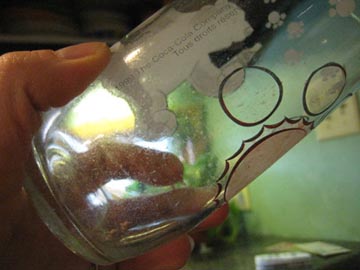
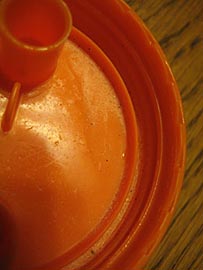
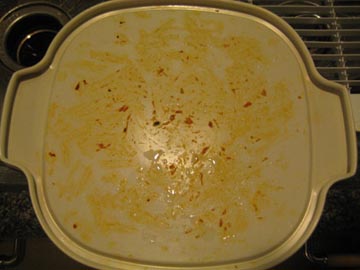
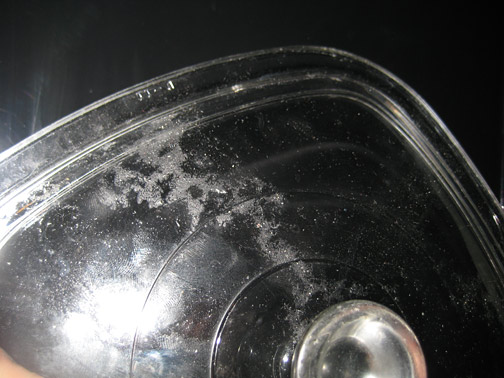
… well, we figured out pretty quickly that there was a problem. I compared the new box of Finish to the old one that was still under the sink and immediately realized what the problem was. (The old box is on the left, and the new, phosphate-free box is on the right.)
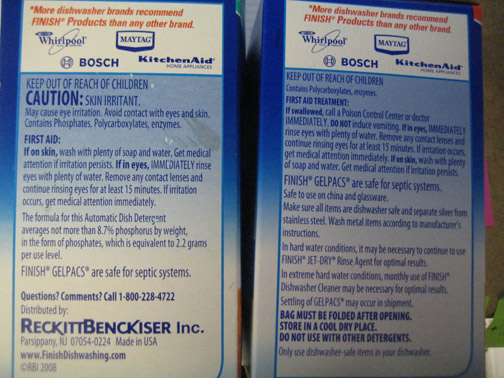
What to do? As some of my blog readers mused over the past month about this new problem we were experiencing (apparently our stockpiles all ran out of the “good stuff” around the same time!) I started looking for answers. I had a few packages of phosphate-free Cascade and Cascade Complete geltabs that I’d picked up with coupons last year too, so I retired the underperforming Finish and gave both kinds of new Cascades a try. With both, I had disappointing results. Glasses were still cloudy, and dishes still had food stuck to them after the wash cycle.
Next, I wanted to rule out the slim possibility that something was wrong with my good friend, Bosch. I needed some phosphate-based dishwasher detergent to run a few loads with and compare the results. And I did have a couple of loads’ worth of the “good stuff” left. We had vacationed in Disney the previous year (2011,) andour Disney villa’s kitchen was stocked with this:
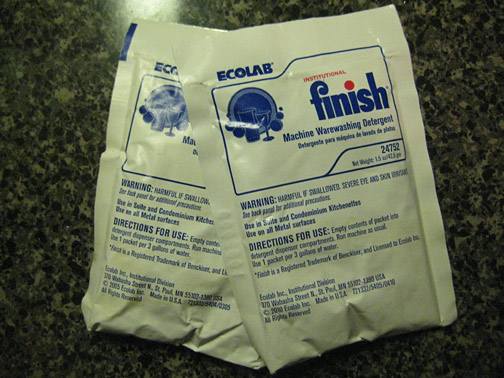
Institutional Finish dishwasher detergent. When we checked out, there were a couple of packets left in our room, and I had brought them home along with the cute Mickey Mouse soaps that the kids like. This Finish contains 7.1% Sodium TriPolyPhosphate. I ran two loads using one packet for each load. And, when each load finished, I opened the dishwasher and was rewarded with a bleachy-clean scent and delightfully sparkling dishes.
It was safe to say that the detergent was a problem, and that Bosch just needed better detergent to do his job again. It’s worth noting that commercial-grade dish detergents (laundry too) are still allowed to contain phosphates, because it’s important for restaurants, hotels, hospitals, and other commercial usages to get their dishes and laundry as clean as possible.
As I knew the Institutional Finish worked well, I started looking online for sources to purchase it from. One hotel-supplies website carries it, but it’s a whopping $102.99 for 200 loads, or about .50 per load. The couponer in me shuddered!
I knew from reading other articles online that some people were having luck with adding TSP (TriSodium Phosphate) to regular dishwasher detergent to get things cleaner. I bought some TSP and experimented with adding anywhere from a teaspoon to a tablespoon to the dishwasher, along with phosphate-free Finish.(If you try this too, make sure you’re getting real TSP — there are actually phosphate free versions of TSP now too!)
I supplemented with TSP for about a week. While my dishes seemed cleaner, they were also covered with white powdery spots:
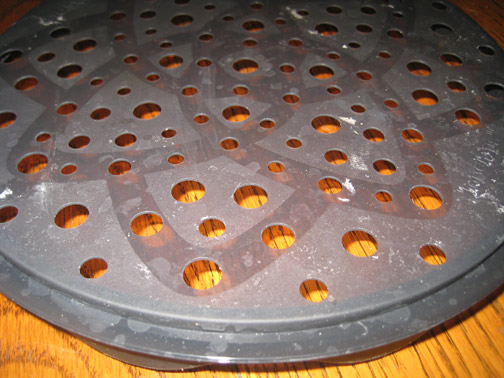
One of my readers suggested using STPP (Sodium TriPolyPhosphate) instead of TSP to get rid of these powdery spots, but I kind of felt like I was done playing chemist at this point. I just wanted something that worked consistently. There had to be a better solution, and I started looking for less-expensive commercial-grade dishwasher detergents to try.
In January, I received a flyer in the Valpak for Bubble Bandit, a new phosphate-based commercial-grade-for-home-use dishwasher detergent. The Bubble Bandit flyer stated the obvious: “$5 says it’s not your dishwasher. Take a look at your detergent. Your phosphate-free dishwasher detergent doesn’t work!” It boasted an 8.7% phosphate content, the same as what my Finish Gelpacs used to contain. I ordered some to try.
Another reader suggested Professional Line Cascade, which is a foodservice-grade version of Cascade that contains those all-important phosphates. Yet another suggested Finish Glass Magic, which is a phosphate additive that you can supplement your phosphate-free Finish dishwasher detergent with. I placed an order for Professional Line Cascade. Surprisingly, Finish Glass Magic is available at some supermarkets. At my reader’s suggestion, I made a rare trip to Woodman’s to pick it up.
And for one month, I rotated these three products, tried them all out, and took notes on what I liked, didn’t like, and would ultimately continue using. At the beginning of this process, I had actually amassed quite a large pile of “didn’t get clean the first time” dishes to try these detergents out with, but as the month went on, I was using them for my regular dishwasher loads too. Here are the results of my semi-scientific Clean Dishes Challenge:
The contestants:
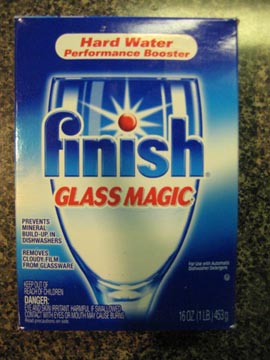 Finish Glass Magic
Finish Glass Magic
Product type: powder
Phosphate concentration: 21%
Active ingredient: Sodium TriPolyPhosphate (STPP)
Contains: 16 ounces
Number of loads in package: 10
Price: $5.49
Price per load: .54
Purchase at: Woodman’s
With a whopping 21% phosphate, I expected good things from Finish Glass Magic. But, it’s also the only product in the challenge that requires you to use it with dishwasher detergent too! It’s not detergent, just a detergent additive.
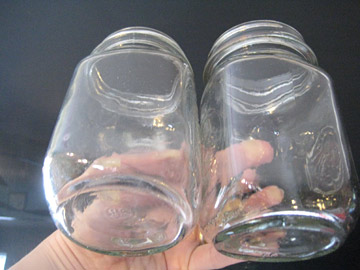
Dirty…
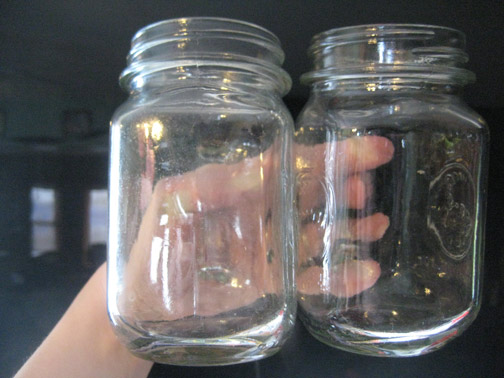
Clean.
Does it work? For the most part, yes. The dishes were definitely coming out cleaner, though in comparison to the other two products tested, I actually was disappointed in some of the loads I ran. Plastics were definitely much cleaner than before, as was the silverware. But some of my glassware was still cloudy when it came out — surprising for a product called Glass Magic, especially considering the high phosphate count. It’s got a very strong bleach scent too, if you’re sensitive to that sort of thing. (I didn’t mind the scent at all.)
Conclusion: At over .50 per load, I think this is just too expensive for daily use. (If I wanted to spend that, I’d simply get the Institutional Finish, which worked much better than the combination of Finish Glass Magic and non-phosphate Finish did.) I also think the other detergents I tried performed better than this. And I think it’s a little ridiculous that Finish can “ban” phosphates from their regular detergent, but still sell you a box full of them to supplement their phosphate-free detergent with.
 Bubble Bandit
Bubble Bandit
Phosphate concentration: 8.7%
Product type: powder
Active ingredient: Sodium TriPolyPhosphate (STPP)
Contains: 60 ounces
Number of loads in package: 37.5
Price: $9.60
Price per load: .26
Purchase at: Amazon
I was looking forward to trying the Bubble Bandit, simply because I liked their advertisement and that it is a new product. The bag notes that Bubble Bandit is a commercial-grade dishwasher detergent for home use. And, the first load I ran with it made me sigh with happiness when I opened my dishwasher up:
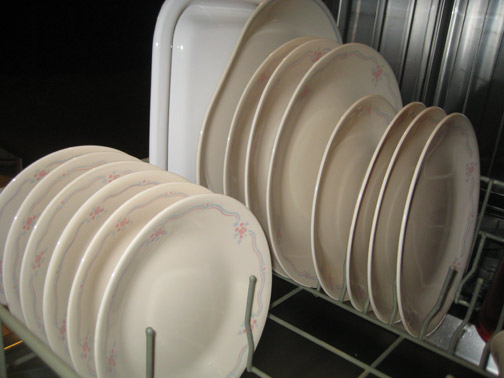
Oh, to have all of my loads of dishes look like this!
I was curious to see how some of the things that didn’t get clean with phosphate-free Finish fared under a phosphate-based detergent, like this pizza cutter:
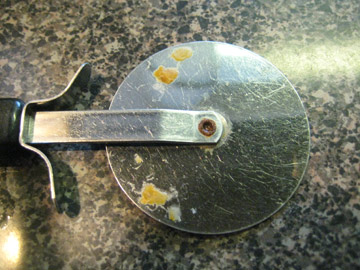
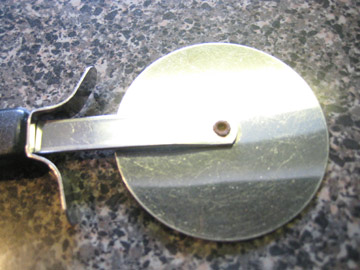
Ridiculously, I felt like a kid at Christmastime when I opened my dishwasher and saw everything that was previously dirty was now clean. (Isn’t that what a dishwasher is supposed to do though?!)
The scent of Bubble Bandit is hard to describe – it has a clean kind of smell, but it’s not evocative of any specific aroma. The detergent itself is also a very fine powder in comparison to the other two.
The only negative thing I can say about this product is that it didn’t seem to work well with my Bosch’s detergent dispenser at all. The Bosch has a sliding detergent door that locks over the detergent cup, then gradually opens during the wash. After the first load, I opened the dishwasher, looked at the dispenser, and saw this:
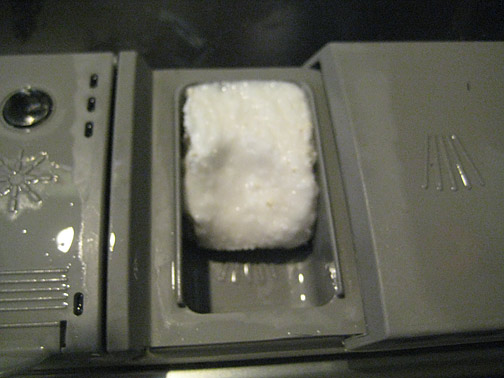
Most of the detergent was still stuck in the dispenser – a white, sticky glop. I used a knife to pry it out:
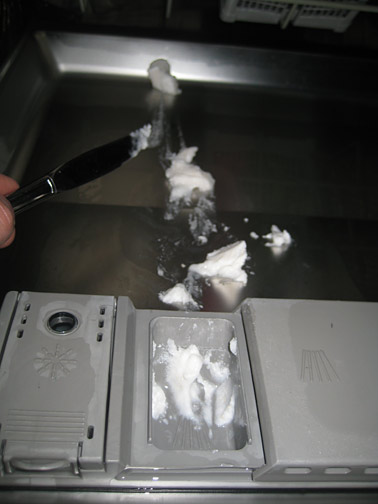
I don’t know if it’s because the detergent is such a fine powder that it’s sticking together when the water is sprayed into the dispenser before it releases the detergent, or what. But the strange thing is that even though more than half the detergent was still stuck in the dispenser each time a load ended, the entire load of dishes was clean and sparkling. (It made me think that I might be able to use a lot less detergent and still get the dishes clean.) After three loads, the detergent was still sticking in the cup after every load (I was cleaning the stuck detergent out completely between each load.) After that, I opted not to use the detergent dispenser at all for subsequent loads. The product came with a scoop to measure with, and I simply scooped out the right amount and dumped it into the bottom of the washer before closing the door. I also played with reducing the detergent by about half the volume of the cup, and my dishes still came very clean. So, a bag of this may go further than the measuring-cup would lead you to believe.
Conclusion: Aside from the issue with the detergent dispenser, I was happy with the cleaning results of Bubble Bandit. There were times I opened the dishwasher to add something once it began running, and even if the dishwasher had been running for less than ten minutes, almost everything appeared to be clean already. What’s not to like about that? Unlike the others, it does not have a strong bleach scent. If you’re sensitive to smells, this would be the best phosphate-based choice.
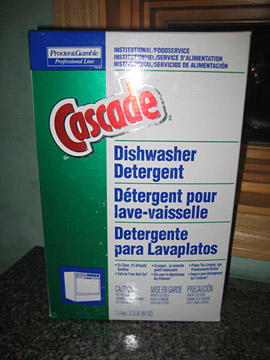 Professional Line Cascade
Professional Line Cascade
Phosphate concentration: 7%
Product type: powder
Active ingredient: Tripolypentasodium Phosphate
Contains: 85 ounces
Number of loads in package: 53
Price: $9.17
Price per load: .17
Purchase at: Amazon
November 2014 UPDATE: Cascade Professional was discontinued about a year and a half after I wrote this article. It has reappeared under the name Cascade Fryer Boil Out, presumably because there are no phosphate bans on deep-fryer cleaning products. The ingredients are identical — you can verify by comparing the boxes side by side at this link. (I did!)
2020 Update: This post is now eight years old and still as popular as ever! I am still using Cascade Professional / Fryer Boil Out to this day with great success. Go read the Amazon reviews of this fantastic product!
I was very happy with the performance of the Professional Line Cascade. Despite having the lowest phosphate concentration of the detergents tested, this Cascade got everything clean that I threw at it, including Corning Ware. If you cook with Corning Ware, as I do, you may know that while its thermal properties are second to none, a lot of foods stick to it. This is what some of my Corning Ware dishes looked like after washing them with the phosphate-free Finish:
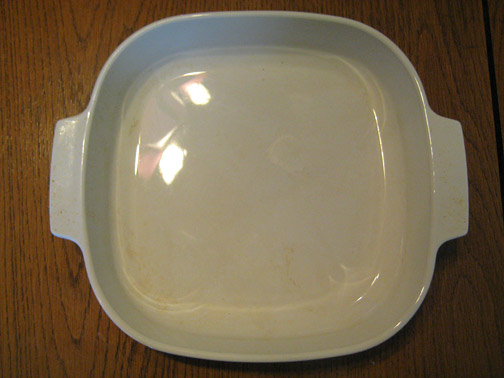

They were sort of clean. But I was still hand-washing them afterward to get rid of food residue. And, worse — the back sides of the dishes weren’t getting clean at all. In some cases, they were coming out even dirtier:
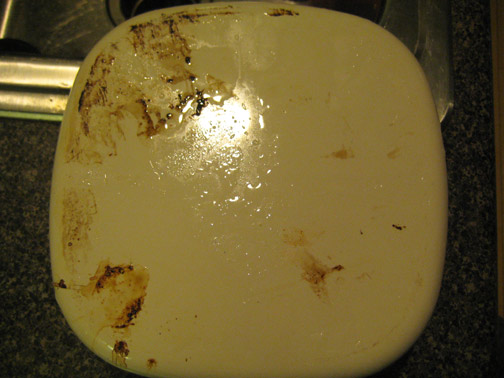
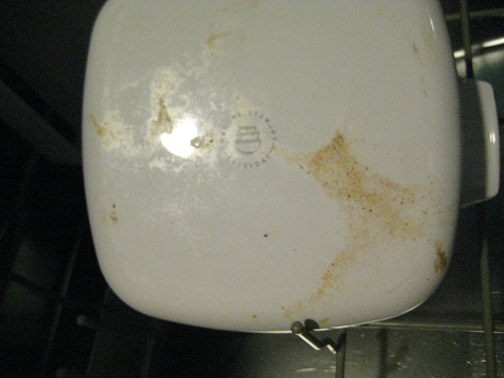
Now, as the top dish had cooked over on the stove, I might have had to scrub that one anyway… but the bottom dish had nothing on the bottom of it when it went into the dishwasher. It was dirtier when it came out, after being washed by the non-phosphate detergent! Yuck. But here’s how they looked with the professional version of Cascade:
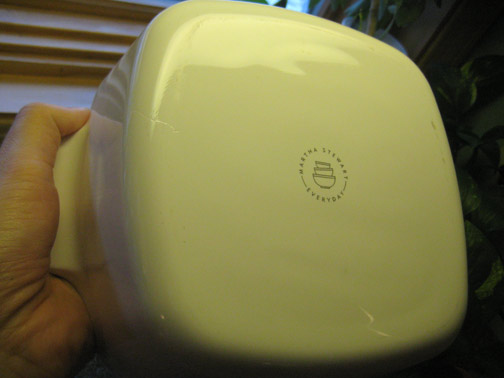

Beautiful! (I laughed after I took the bottom photo. Look closely at the pan on the lower left. The kitchen light is giving off a heart-shaped reflection in the glass, as if to say “Don’t you love your clean Corning Ware?” Yes, I do!)
I had very consistent results with the Professional Cascade. It worked fine in the detergent dispenser of my Bosch, though again, if you’re a smells person, it’s got a strong bleach smell when you open the dishwasher. (Again, I don’t mind and actually like it… to me, that smell means “CLEAN!”) I honestly couldn’t come up with anything negative to say about this. It cleans like it’s supposed to. ‘Nuff said!
Conclusion: Of the three, this is the best value of the bunch. It’s only slightly more expensive than the Bubble Bandit, but it has an extra 25 ounces of detergent in the box. And it reminds me of the Cascade I used to buy. (Well… it pretty much IS the Cascade I used to buy.)
November 2014 UPDATE: Cascade Professional was discontinued about a year and a half after I wrote this article. It has reappeared under the name Cascade Fryer Boil Out, presumably because there are no phosphate bans on deep-fryer cleaning products. The ingredients are identical — you can verify by comparing the boxes side by side at this link.
2019 Update: This post is now seven years old and still as popular as ever! I am still using Cascade Professional / Fryer Boil Out to this day with great success. Go read the Amazon reviews of this fantastic product!
Other things you should know:
All photos are unretouched and unenhanced. If you wish to zoom in and inspect my dirty dishes, or admire my clean ones, you can. The number of loads of detergent in each package was calculated by pouring each package out and measuring the specified load size with the appropriately-sized measuring cup. (Then, I poured it all back in with a funnel!) No rinse agents were used with any of these detergents, though I was previously alternating usage of Jet Dry and Safeway’s house brand Bright Green citric acid dishwasher rinse (similar to Lemi-Shine) with my nonperforming phosphate detergents. Now I haven’t needed rinse agents at all.
If you’ve followed this issue at all, you may know that phosphates were removed from detergents due to the perceived threat of algae bloom in fresh water when grey water containing detergent runoff emptied into lakes and ponds. While algae bloom is a problem for fresh water, the usual culprit is runoff from commercial fertilizers, which contain high amounts of the kinds of phosphates that can cause algae bloom.
A Minnesota study determined that the amount of phosphates generated from home use that were actually reaching bodies of fresh water was about 1.9%. And, in 2011, the University of Washington released a study that determined that phosphorous runoff from detergents, even when discharged directly into the Spokane River, never worked as an algae fertilizer: “Effluents making their way into the river contained phosphorus in complex molecular forms which are not bioavailable. Algae lack the enzymes necessary to break down this phosphorus, meaning it is essentially harmless.”
So, even in a situation where phosphorous-based detergent runoff is emptying directly into fresh water, the phosphorous doesn’t cause algae bloom. But now that science has proven otherwise, will the ban be lifted? Not likely. “Detergent phosphates are bad for the environment” has become a common belief among environmentalists and many consumers alike… even without any factual evidence. On the contrary, studies exist showing that this kind of phosphorus is not an issue.
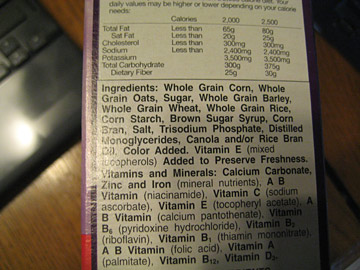 Phosphates in and of themselves aren’t “harmful” at all either. They exist naturally in the environment, and if you’ve eaten a box of Cheerios lately, you’ve been eating them too (check out the ingredients in the photo at the right.) As one of my readers wrote here on the blog, “If TSP is so harmful to the environment, why is the government allowing our families to consume it when they allow General Mills to add it to their cereals? … Yeah, its dangerous to be in the water, but its okay if we consume it… Talk about mixed signals!”
Phosphates in and of themselves aren’t “harmful” at all either. They exist naturally in the environment, and if you’ve eaten a box of Cheerios lately, you’ve been eating them too (check out the ingredients in the photo at the right.) As one of my readers wrote here on the blog, “If TSP is so harmful to the environment, why is the government allowing our families to consume it when they allow General Mills to add it to their cereals? … Yeah, its dangerous to be in the water, but its okay if we consume it… Talk about mixed signals!”
Reader Frank Schroeder wrote to the New York Times, “What evidence supports the notion that ‘phosphate-free’ detergents are better for the environment, better for the people using them? As a chemist, I can hardly think of a replacement that is less innocuous (and less of a concern for human health) than phosphate.” Indeed.
With the removal of phosphates from detergents, the cleaning power of phosphates has to be replaced with something. Typically, petroleum-based additives are used in conjunction with enzymes. In Europe, The Centre Europeen d’Etudes sur les Polyphosphates and the European Chemical Industry Council has studied this, raising an interesting issue — the phosphate replacements may be more harmful to the environment. These organizations state, “Most such chemicals have poor environmental biodegradability and can significantly increase the organic compounds in the sewage. The additional chemicals also pose a toxic risk to aquatic and terrestrial ecosystems” (link) Food for thought.
Situations in which dishes must be absolutely clean and sanitary demand detergents that work. It’s the reason the professional grade detergents used by hotels, restaurants, and hospitals still contain phosphates.
The Weekly Standard article, “Another Triumph For The Greens,” has a great deal of additional information about this topic if you’re interested in learning more.
Additional reading:
Another Triumph For The Greens: To go with toilets that don’t flush and light bulbs that don’t light, we now have dishwashers that don’t wash – Weekly Standard
Dishes Still Dirty? Blame Phosphate-Free Detergent – NPR.com
Cleaner for the environment, not for the dishes – The New York Times
Bubble Bandits Defy Dishwashing Soap Ban – NPR.com
Your Dishes Are Dirty Because Of The Greens – Red State
How Phosphates Help Detergents Wash – The Centre Europeen d’Etudes sur les Polyphosphates (2012 archive link)
Consumer Reports reviews phosphate-free dishwasher detergents – ConsumerReports.com (2012 archive link)
Cascade.com on phosphate-free formulations– Cascade.com (2012 archive link)
Negative on-phosphate product reviews on Cascade – Cascade.com (link no longer active)
Disclaimer: I have not been compensated for this post, nor have any of the companies involved provided products for the purposes of review or inclusion in this article. I purchased all three products tested for the purpose of sharing my results with my readers… as well as finding a good dishwasher detergent that I can rely on.










ldurec says
I just made my poor husband rip apart the dishwasher & clean everything because my loads were just not 100% clean…that still didnt work! Now I know to try a different detergent :)
Mike says
I try Cascade fryer boil out and i am not happy with it because it messed up my aluminium cookware for eg pressure cooker and other aluminium cookware it make them so dark Cascade fryer boil out might be contain Bleach. i was using Finish dishwasher detergent long time a go and it cleans so well sparkling clean even aluminium cookware but now it dosen’t clean any good
Coupon Maven says
Aluminum should never go into the dishwasher (with any detergent) – most aluminum is not anodized and will oxidize badly in the dishwasher. Google “never put aluminum in the dishwasher” and you’ll get over 400,000 results why:
https://www.google.com/search?q=never+put+aluminum+in+the+dishwasher
You can try a paste of cream of tartar and water – scrub with a cloth to remove the oxidization and then wash by hand in the future.
Mike says
Ok i will that coupon mom ….
amjacobs909 says
Jill,
This is a wonderful article. So well written and so much information! I’m going to show this to my Mom and Grandma. I’m thinking about buying the Professional Cascade. Maybe I can share a case with my mom, since she baby-sits my children and has to deal with all their dirty dishes.
Thank you very much for your hard work!
msugradstudent says
Jill, thank you for sharing this great information. It is really appreciated! :)
marycare says
I have been very frustrated with my dishwasher lately and was getting ready to call a service guy in to check it out! Great article. Thanks for all the research and time you put into this.
Do you use a “jet dry” type product in your dishwasher? Have you found this to helpful at all?
palatino says
We have been waiting patiently since you said you would do a detergent challenge! We are having the same problem with the new dish tabs. They don’t work at all for us.
Just in case you liked the Ecolab Finish powder too that you tried first, I found boxes of it on the hotel supplies site you had, you don’t have to get just the packets:
https://www.americanhotel.com/Products/Ecolab-Finish-Dishmachine-Detergent-for-Undercounter-Machines-50-oz.aspx?R=RDB11720
It is $117 for 10 boxes, 50 ounces each. That would be $11.70 each. The Cascade still has more in the box, costs less and seems like the best bet. Thank you, thank you thank you! Looking forward to clean dishes soon!
brandon123 says
I live in the country and have well water, so this is always a problem for me. At least once a week I use this product called Lemi Shine. I buy it at walmart (many other places cary it) there are 12 uses for about 3.00. I just use it as a replacement for dishwasher detergent for a cycle. It cleans the didhes and the dish washer. Glass, plastic, all great!!!! It is phosphate free, but don’t judge before you try!
Momma Goddess says
Article states “. . . In Europe, The Centre Europeen d’Etudes sur les Polyphosphates and the European Chemical Industry Council has studied this, raising an interesting issue — the phosphate replacements may be more harmful to the environment. ”
Maybe we can get the aforementioned to do a study on the ridiculous outlawing of incandescent light bulbs for the “cute, curly, and very safe, with no poisons” light bulbs (to be read with all sarcasm intended). Sheesh, glad I’ve stockpiled those too.
We’ve got a reprieve, but not sure if the “people” will prevail on this one either.
https://www.forbes.com/sites/christopherhelman/2011/12/16/congress-kills-light-bulb-ban-sort-of/
Great article Jill! Now, we gotta find coupons :o)
Outlander says
I hate to say it guys, but I have no problems with my Finish tabs at all. I load my dishwasher very full, and, unless something accidentaly nestles in something else, everything comes out perfectly clean. I do use Jet-dry too.
Supermom10 says
We have noticed that our dishes were not getting clean and switched detergents and now we use Finish tabs & when we do not have those we use Cascade Advanced Power. Since we changed, our dishes are clean.
sbdmmd says
Not only are my dishes not as clean, there is now a blue residue on the inside white panel of the door. It is gross. I at first thought that one of the packets just got stuck and oozed down the door. So I cleaned it all up and then sure enough the next batch the door had a blue hue to it. This is with generic as well as name brand.
Just imagine what is stuck on the dishes! Yuck.
mr.deal says
you have 3 kids, have them wash them by hand and that should do the trick
ymacorr says
The web site that you link to gives you a 6% discount if you order 2 cases (or more) and you can get $10 off a $100 order. SO that’s kind of a lot to spend at once, but it drops the price to $7.76 per box or about $0.15 per load.
hobbitgirl says
Phosphates were also removed from Laundry soap at the same time. we add powdered TSP to the laundry soap in our HE machine, just a half teaspoon per load, along with 20 Mule Team Borax if it’s really dirty stuff.
april says
How much Veinte Caballo Boracho do you add to the washer? How much detergent? How much TSP? My laundry has been accumulating a dirty cast and I thought it was from a prior tenant using the machine leaving filthy water in the bottom! All this time, it has been my DETERGENT!
Rocketmom60 says
I knew there were food police but now we have dishwashing police also. Until we get people in the government who is not in the pocket of environmentalists, so-called health experts and their ilk, you can count of there being more and more restrictions on what we are allowed to consume. I read in the Wall Street Journal just yesterday that the food police are now targeting sugar. So we need to find out who among our congressional/senate/presidential representatives are supportive of these policies and vote them out of office so some sanity can be returned to this nation. End of political rant.
Regarding the dishes….I use regular cascade gel with a rinse agent in my stainless steel tub GE dishwasher. The dishes get clean so no problem there. I do have some scum around the edge of the door so I have to clean that. And there is some calcium or lime residue that goes from just under the detergent cup down into the bottom of the tub. So far I haven’t been able to remove that. I’ve tried CLR but maybe I need to scrub it a little more.
savings4me says
Jill, I read your previous notes a few months back regarding the challenges with dishwasher detergent. Until I read your commentary, I really thought I had a horrible dishwasher, it is a GE Profile, about 7 years old. It has never cleaned my dishes to my expectation, but I agree it seems that removing the phosphates from the detergent certainly didn’t help. I didn’t start using the Finish tabs until I started to get into couponing and stocked up last year. I noticed on the gel tabs there is a note on the box stating you must fold down the inside bag. This is also on the box you have in your phosphate-free Finish photo above. Any idea why? I did noticed that when I am near the bottom of the box and perhaps the inside bag unfolded, the gel tabs were kinda krusty (sorry, can’t think of a better word). At first, I thought one maybe busted in the box, but nope. When I use those krusty tabs, they clean the dishes even less than normal. Any thoughts on why that is?
cschelthoff says
I, too, noticed that suddenly my dishes were coming out with “stuff” still stuck to them or strange marks on glassware. Hadn’t realized that I’d started using my non-phosphate stockpile. Started using two tabs in the dispenser and the dishes come out completely clean once again (I only run the dishwasher every other day). Since I never pay for this stuff in the first place, I have no problems with using twice as much!
Flag1 says
Now I know. Thanks, I thought it was our hard water since the city went to a different water source.
lenkym1 says
I was concerned since we just got a new dishwasher in November, and I haven’t been happy with the cleaning…but thanks for your article because now I figured out it’s the detergent! I’m gonna have to order some of the good stuff!
driendeau says
I found the Cascade that was the “big winner” at GFS in Palatine. $7.99 for a large box.
rintjm says
I’ve been using this since before the phosphates got phased out, and it’s always worked great. It has to be the powdered kind, and you do have to pay for it, but I like the company and I definitely like the results. We were given some free detergent by a friend whose dishwasher broke, and we used it for a long time, because it was such a big jug. Then one day I thought, wow, our dishes are really clean lately. I realized we’d run out of the hand-me-down stuff and were back to our seventh generation powder. Coincidence? I think not. :-)
lovedeals says
My glasses (glass cups) are embarrassing. They are so foggy with residue. I sometimes wash them by hand in the sink and add a cup or two of vinegar to the water/soap. The vinegar takes the film off my glasses. Makes them look clear again.
SaraW946 says
I just ordered Cascade because from Restockit which offers an additional $10 discount! They made me click on the box that said “for commercial use only,” and I will have enough for 636 loads, but, frankly, I cannot take it any more! I simply have no time to wash everything by hand, and I didn’t use TSP properly anyway. At the price I paid, it comes down to .146 per load!
what2buytoday says
Been struggling with the dirty dishes knowing about the change that happened back in 2010.
Its amazing that these genious’ that come up with these ideas dont think out the ramifications of their actions. How much is the environment being hurt by people wasting two loads worth of water instead of one on getting their dishes clean. All the extra scrubbing utensils going into landfills, two times the detergent used and what goes into manufacturing that, the water processing plants using more resources and electricity due to increased water usage which probably does more harm to the environment then the original concern. These guys probably patted themselves on the back thinking they did something good for the environment. All they did was pass the buck.
theresa1740 says
Wonder if “the contestant” companies will take note of the complaints on their products if you were to send this blog info to them.
Paintedlady says
Jill, I appreciate all the time you took to test these different detergents and give us the results. You always give me food for thought.
It’s interesting that I also have a Bosch and have not noticed any difference in my dishes with the phosphate-free detergent. My glasses always come out sparkling, and although the odd dish may need extra cleaning, that happened in the past as well with the “old style” detergent. Maybe it’s because I typically pre-wash, or at least rinse the dishes before they go in? I also wonder if it has anything to do with having soft or hard water?
Calibabydolly says
There is another article in my local paper about TSP today! I went out this week and bought the 4.5 lb box of TSP to add to my new formula gel dish detergent that was not cleaning the dishes properly.
I tried my 1st load, but was unsure how much TSP to use. I thought someone here said 1 tsp of TSP per load added to the crappy soap? Well I did that, and it was a bit better, but still not like old Cascade. My coffee carafe and clear glasses were still a bit streaky and the lipstick marks were not gone. (I wipe each glass as I put it away) I am getting tired of doing that!
The article in Everyday Cheapskate said one person mixed EQUAL parts TSP with dishsoap. She said to go buy the commercial stuff at GFS because she could not personally recommend the TSP. My ratio was 1 tsp TSP: 2 Tablespoons gel soap.
Has anyone used equal parts? How does that come out? I will run my next load that way and see, but that seems like too much TSP? I don’t want to be unsafe or ruin anything.
DalerioMom says
Hi Jill, I’m so glad I recently found your site. Regarding dishwashers, my Mom found the bubblebandit soap and told me about it. I’ve been using it for about 6 weeks and have been very pleased with the results. But, when I turned my sister-in-law Mary, in Grand Rapids, MI, on to it, she described the same “gunking” in the soap reservoir that you experienced. She recently remodeled her kitchen and also has a Bosche; she contacted the warranty service and they told her to cut the amount of detergent she was using in half (or use a liquid gel). She did, and said the Bubblebandit is working wonderfully for her (plus she’s using much less, so it’s turned out to be pretty economical – good for her big family). I am fairly new to couponing, thank you so much for making this site for the rest of us!
The Bubble Bandit says
Thank you Jill for including Bubble Bandit in your dishwasher detergent challenge. We spent over a year developing the Bubble Bandit formula prior to launching January 4th of this year. Your experimenting on just how much powder to use mirrors our own conclusions that no more than one tablespoon is needed for each wash cycle. I wish we had discovered that prior to purchasing 50,000 printed bags..oh well, the fact of getting 60 wash cycles out of each bag makes up for it! The newer “energy efficient” dishwashers like your Bosch seem to be the only ones that have that “caking” problem you experienced. We are introducing a gel with 8.7% phosphate later this summer for those type of machines.
http://www.Bubblebandit.com is the little David battling the big Cascade Goliath so folks…please remember that when you decide what to order. We need your business and you need clean dishes..give us a try.
Phil Morren
President
Bandito Products, LLC
erika727 says
Yeah, I ran out of my stockpile of the old stuff too. With the new phosphate-free detergent, it is horrible. I am so glad there are still detergents available to me! Thank you so much for writing and researching this article! I have noticed with certain brands that it takes a few loads until you really notice the difference of the phosphate free detergents. For me, the Cascade gel pacs tend to leave residue on dishes which becomes more and more noticeable after several loads. Now, I am having it happen with the finish tabs too! I had checked consumer reports for detergents; do you know since the phosphate free versions came out, Consumer reports doesn’t recommend any of the brands it tested?
hammar says
Look! Sam’s club has the cascade with phosphates!
https://www.samsclub.com/sams/shop/product.jsp?productId=194975#desc
Check out the comments.
Was talking with my MIL, and she looked at her box of Member’s Mark detergent, and it also had phosphates!
Easy pick up instead of ordering!!
PatK says
I noticed the coupons in this past Sunday’s paper for Oxi Clean Dishwashing Booster. It looks like this is supplemental phosphates to assist the new dishwasher detergents.
https://www.oxiclean.com/dishwashing-booster/Products/oxiclean-dishwashing-booster.aspx
LilBlossom says
I FINALLY got fed up with the terrible results my dishwasher was doing and I am sending my husband to GFS today to pick up a box of Cascade. I read this review way back when, but it took me this long to finally do it :o)
jerryl says
We have well (hard) water and ran into the problems described here – and ended up (unnecessarily, most likely) replacing our dishwasher. (Well, the old one was having problems anyway.)
Eventually, someone suggested one of the commercial “wash boost” products. We tried it, it worked – but it was absurdly expensive. (Box with two little packets and tons of air cost several dollars.) I was able to figure out what was in it, though: Citric acid, also used in various “clean your dishwasher” products.
Citric acid is actually sold for cooking things like preserves, sometimes under the name “sour salt”. If you look around the internet, you can find sources of bulk food-grade citric acid. I toss about a eighth of a cup of the stuff into the bottom of the dishwasher with each load, and stuff actually comes out clean for the first time since the formulas changed. Since much of the problem seems to be long-term buildup, a little in each wash, it would probably work as well if used every other time. (The expensive little packets recommend “once a month” or something like that.)
We don’t generally wash pans and such, so I can’t comment on how well it will work for baked-on food. Citric acid is an excellent chelating agent, and is used in industry to clean metals. (Obviously, you don’t want to buy the lower-purity versions sold for that purpose to use on dishes!) I suspect most of what it’s doing for me is making my hard water “super soft”. So it may not help as much if your problem is *not* hard water.
Trebbs says
One detergent I didn’t see here (I think it has come out since this article was made) Bright and Fresh.
They don’t seem to be a very large business, but I have been buying their detergent for a while now and it works fantastic! It has phosphates in it, and I really haven’t had any issues at all with it. It leaves my dishes very clean! They come in 10 lb buckets, so the shipping can be expensive, but they are only $23 per bucket (not including shipping.
You can get it on Amazon here: https://www.amazon.com/gp/product/B007K9LVJS/ref=as_li_tl?ie=UTF8&camp=1789&creative=390957&creativeASIN=B007K9LVJS&linkCode=as2&tag=jillcatasupec-20&linkId=WG456BOQ23AUC5VV
It works great, I would highly recommend it to anyone still unable to find a detergent that works for them.
macattack says
Hello
I stumbled upon your blog in the process of researching my grimy problem. I want to thank you for the informative article, but also for saving me a whole bunch of work! This is excellent research, very thorough and objective, and well documented to boot.
I went through the same exercise as many; disassembling the machinery, looking for problems, changing the way I load the racks, pre-rinsing more, not pre-rinsing, descaling, hotter water, cooler water, etc. It is shocking to me the amount of misinformation that is floating around out there about this obvious problem; and it is not without a price, as you constantly hear about people complaining about machine performance, only to end up paying for new pumps and other repairs, and even going so far as to replace the entire machine. It is surprising to me that the manufacturers would tolerate this. thanks again- you are making a difference!
macattack says
I have been able to find many recipes for homemade dishwashing detergents, but I am still interested in developing my own so that I can tailor it to our specific conditions. We have hard water from a well, and I am convinced that the regular addition of citric acid is necessary for a variety of reasons/conditions.
However, what I have noted is that even in powder form, combining the citric acid with the TSP powder produces a reaction, and gasses off something. As such, I am skeptical about the potency of anything that is made up ahead of time. My original plan was to simply add the powdered TSP and Citric Acid to a high quality brand-name powder. I am wondering if the reaction I observed is just the result of high humidity, or will it always occur? How do the detergent manufacturers make the liquids,then? Is there a Chemist in the house????
mr_eltz says
Great article, thanks. Been using Bubble Bandit for about a month with fantastic results. I have had detergent caking in my dispenser for a couple of years and bubble bandit was doing the same. About three months ago I went so far as to order a new dispenser, because the door seal on the dispenser lid was worn and I thought that might have been letting water in before the door opened to dispense the detergent causing the caking (and I couldn’t find a replacement seal.) This weekend, I was thinking more about the problem while unloading the dishwasher, and I noticed the detergent dispenser would be roughly aligned, when the door was closed, with the “sprinkler arm” that is attached to the bottom of the top rack and sprays water up into the dishes on the top rack. I immediately realized that putting a small hole in each end of this sprinkler arm would squirt water into the dispenser cup and rinse the detergent out. Then I thought, I bet it has hole already, and I bet it is clogged. I inspected the rotary arm, and sure enough, in addition to the 4-5 upward pointing holes in each half, there was another smaller hole in each end pointing outward that lined up perfectly with the dispenser cup. It actually had a little plastic deflector that looked like it was made to deflect the stream directly into the dispenser. And I could see it was in fact clogged, (and so was the outermost upward facing hole on each side, in fact). I was able to take the arm out of the dishwasher with a small wrench, and although I could not open it up to clean it out, by running water through it, and using a toothpick, I was able to clean all the debris out eventually. I think the outer 2-3 inches of this arm were completely full of debris (!) and it took about 20 minutes to clean everything out with a toothpick and running water (there was some particularly stubborn hard plastic bits in there from something that must have disintegrated inside the dishwasher at some point.) But by rinsing from one end to the other, and then tapping, and then rinsing the other direction, I was able to eventually get everything out. VIOLA! I have run about 4 loads since then and the detergent dispenser is completely empty every time. We haven’t had a single load without the caking in 3-4 years, much less four in a row. Problem Solved!
macattack says
Good advice on the tip of the arm being clogged. All of the stubborn clogs I have encountered are near the end of the arm, and not easily noticed because they tend to fall back into the arm when the water stops flowing. There always seems to be some chewed-up plastic….
On a related note, I wanted to mention my findings on the caking issue. First, filling the dispenser way in advance of running the machine always seems to lead to this. I am guessing that any moisture that is lingering in the cup causes the formula to begin reacting, and it becomes a solid mass quickly. The other problem I have noted, which may be worse on models with adjustable height upper racks, is that if you get the upper rack set to just the right height, and you have some irregularly shaped objects positioned in the front corner, it is possible for the objects to protrude enough to actually block the door from flipping open all the way. So again, just like the bottom rack, you need a consistent strategy on where to put what.
CFOof5 says
I went to GFS a few weeks ago looking for the professional Cascade with phosphate. The shelf was empty. I asked an employee if there was more in the back. He looked and said no, try back later. I was out that way today so I stopped in. They had professional Cascade in stock, but it was now in blue box with the words “Phospate Free”. I know others have mentioned finding it at Staples, so I looked online and it’s out of stock. I’m wondering if they are discontinuing it.
Outlander says
I am thinking about trying this Bubble bandit. Do you guys still think its good? I noticed that the same size bag is now $15, instead of $10, but if you buy 2 for $30 it’s free shipping. That just seems so pricy, so I’m not sure. Thanks!
GingerC says
I found this post a while ago and it saved my dishwasher. I’ve been buying the Professional Cascade pictured above at my local restaurant supply store. But to my horror it was no longer there last week. It was replaced with a new Professional Cascade that does not contain phosphates. I think the old formula is discontinued. :-( https://www.pgpro.com/brands/cascade/cascade-professional-powder/
I bought it anyway and it works ok, better than what you can buy at Walmart but not as good as the old Professional Cascade formula. I would love to hear your thoughts on this new product vs the others you have tried. I think I’m going to try Bubble Bandit next time. Thanks so much.
macattack says
Well, I discovered the same thing- availability of this product is diminishing, and prices on remaining stock are going way up. I am trying out one of the suggested places-I will update when I confirm that I have received the correct product.
Wondering… Does this mean that the commercial/professional versions are subject to the same laws, it has just taken some time to go into effect? Or maybe pressure from environmental groups? Either way, this is the reason I was wanting to experiment with my own mixtures.
I wonder if you could use the Finish Glass product, combined with a low cost powder and achieve good results at a reasonable cost? Or simply add maybe a teaspoon of TSP powder to a budget powder and get good results? I don’t want to turn the process of running the dishwasher into some kind of ritual, but there is no way that I am going to revert to using the non TSP products at this point. From the months of using the Cascade Professional, I can tell you that not only are the dishes a lot cleaner, the DISHWASHER itself is a lot cleaner too. Somewhere I have seen large cylindrical plastic containers that had separate compartments; I am picturing a tall triple container which keeps the 3 ingredients separate until you open the top and pour. One compartment with economy powder, one with citric acid powder, and one with TSP. I would like to say I could save money this way, but so far that has not been my experience.
Outlander says
I just bought 2 cases of Cascade Pro with phosphate from Restock it and added a few more things to get free shipping. I also found that Ebates gives 5% back, so even better.
Mich says
Unfortunately, due to environmental laws passed in the state of NY, and expected legislature to follow in other states requiring levels of Phosphates to be limited to 0.5% in Commercial/Institutional Cleaning Products, Procter & Gamble has stopped production of all Phosphate containing automatic dishwashing formulas, including Institutional Cascade, as of 8/31/2013.
Jill, I think the end is close to near for the “black market” dishwasher detergent. :(
macattack says
Hi,
Since quantities of the phosphate product are running low, I wanted to pass on my experience with a vendor (I assume you don’t want me to use the name?). They were advertising the correct product, but delayed shipment to me, and when I asked about it I was reassured that all was well. I told them I would gladly wait, but that I did not want a substitution. So, you can guess the rest. The shipping cost is too prohibitive to return the substitute I was shipped, so I am going to use it to experiment on my own formula with phosphate added. I overpaid for a case of non-phosphate that I could have picked up locally as needed. Getting a bad deal is one thing but I really don’t appreciate being dismissed this way.
Pollysmom says
Finish Power Up Booster agent. I tried buying some Cascade from Sam’s thinking it was the same as the professional one I get from GFS and it wasn’t. It left this white film on the dishes no matter how little I used. I can’t find the Finish Booster in stores so I ordered 4 bottles from Amazon. When we use that with the detergent, the dishes come out spotless.
macattack says
I want to be fair and inform readers here that I did in fact receive a full credit from AVM on the purchase of the misidentified product. They were not very forthcoming in explaining how this happened, and in a way, that sums up the entire experience. I would have expected some kind of communication before shipment to inform the buyer that the product ordered was no longer available, but a substitute was.
What put me over the line as far as suspicion, however, was that the original invoice I received prior to shipment (for the good stuff), was altered at the time of shipment to reflect the change to the non-phosphate product. If it was a complete mistake, I wouldn’t expect this to be changed, so I am forced to conclude that whoever changed it knew what they were doing and either thought it didn’t matter or just didn’t care. (Believe it or not folks, some people aren’t obsessed with dish soap). I will chalk this one up to experience and move on. I really don’t think I want to order any more after this; I know it is still available, but the short supply and ever-increasing price means it is time to come up with a good “homebrew” or at the minimum, some kind of “booster” product, as I see others here are already doing. I have all of the ingredients and I will report back when I think I have a good mix to try.
macattack says
Hi Jill and other fans of washing dishes!
To update you on some of my experiments with making my own Hi-Octane dishwasher powder: First, some basic background. If you have researched this at all you will find all kinds of “homebrew” recipes using a wide (sometimes bizarre) list of ingredients. I am not commenting on the effectiveness of any of these. My intention is to duplicate the performance of Cascade Professional at a cost comparable to what we might all be paying to ship it in by the case. For now, my ingredients list is: 1. Cheapest, best quality non-phosphate dishwashing powder I can find, 2. STTP (Sodium TriPolyPhosphate- version of TSP commonly used), 3. Citric Acid. Both the STTP and the Citric Acid can be purchased in bulk for around 2 bucks per pound, while the detergent powder best price I have found is currently around 80 cents/lb.. Washing Soda and Borax can also be purchased in bulk, but I am not finding either at less than 80 cents, so for now I am sticking with the commercially available dishwasher powder(mostly made of washing soda).
Trial #1: 1 part Citric Acid, 1 part STTP, 2 parts dishwashing powder. (By Volume) The results with this were fine.
Trial #2: 1 part Citric Acid, 1 part STTP, 3 parts dishwashing powder. I am currently testing this,
and so far I have not noticed a performance difference.
Obviously, the key is finding the least amount of the expensive ingredients that will boost the performance. I would prefer to have a single blend like this rather than keeping all of the separate ingredients available and having to add each one every time you run a load. My guess is that if you have soft water that this formula might be too potent. We have well water with a fairly high hardness, so the citric acid is also a descaler as well as a dish cleaner. We also typically use Lemi-Shine as a rinse agent. Since the newer dish detergent formulas use enzymes instead of TSP, there is the possibility that we could hit upon a formula that is even more effective that the old types, but I believe there is a limit to how small and concentrated this can be made and still be effective: as with many of the “homey” natural concoctions, there is a difference between getting the crud off the dishes and really making them sparkle.
macattack says
I had to come back and correct my spelling- STPP-sorry about the mistake.
Coupons2000- where were you a few months back when I had all these questions? I hereby anoint you the unofficial blog detergent chemist.
Regarding the addition of the citric acid, I will try some mixes without it as you have suggested. Maybe I have to resort to an empty load run every month with citric acid only to keep the scale down? Concerning the enzymes, from my experience it would require some type of programmable dishwasher so that the enzymes were mixed and circulated and then the machine stops for a long period of time to allow them to work- at least that’s the way the enzyme drain cleaners operate.
I have not had good experiences with the modern Gels or liquids as you suggest, in fact, these products are what drove me back to the powders. I don’t know why.
The question I would most like answered is about using regular TSP, which is cheaper than STPP. From experience, I know the regular TSP is a little harder to deal with- maybe solubility differences? It seems difficult to rinse when you get too much. I am wondering how many people are successfully using TSP instead of STPP? I have experimented some, but I am concerned about the proportion and whether we end up eating a lot of it stuck to the dishes?
Having said all that, I have tested both of the mixes I listed previously and both have worked well, at least better that the newer boxed formulas without any TSP products. Admittedly, my testing is not nearly as scientific and thorough as the Coupon Maven…. So with a little more help I am hoping to fine-tune things and mostly lower my costs. Thanks for the feedback and suggestions.
Mich says
It’s Gone Guys. It’s Gone :(
I saw this message, on the Restockit Link.
We’re sorry to report that P&G has stopped production of Cascade Dishwasher Detergent (34953PG). Our supply has run-out, but we have lots of other great dishwasher detergents to choose from on our site.
Is there any known, “Legit” suppliers still left?
adaisy says
First of all, am loving this post and all the useful comments. : )
Because of it, I ordered some STPP off of Amazon, but when I read the Material Safety Data Sheet that came with it, I’m afraid to even open the bag! For those who have tried supplementing with this, how did you work with it? How much did you add per cycle?!
Mush in TN says
First of all, to Jill; I went through the same gyrations as you for my clean dishes so I am totally with you on this. Thank you for your research and your post. Ok ladies, here’s the good news!! I befriended the staff at a local Residence Inn, where they use those little Finish packets for use in the dishwashers in the rooms. I asked them to order me a case of the boxes – and they agreed!! I have been supplied with Institutional Finish for two and a half years. They must have Ecolab as their supplier to get it. I buy by the case and it’s only $40 bucks which lasts me about a year. Go to your local residential style hotel, (they have kitchens) and ask for the head of housekeeping. Cry, beg, bribe if you have to but each hotel is usually a franchise and not part of a big conglomerate so they are very accessible. These ladies are people too and in my case, I was nice and they agreed to get it for me. Seeing spot free, film free glasses is my fix; I am a phosphate junkie. Good luck!!
Mich says
Combo, works great. It has a pretty strong Chlorine Scent, just like the Cascade Pro, and is really cheap. :)
Mich says
I’m kinda curious.. does your Bosch actually hold a lot of stuff? Do you like the rack design on it.
I have a Bosch, myself, and as much, as I like the cleaning it does.. I don’t feel like it holds anywhere near the amount of dishes, my old *american* whirlpool did.
Annoyed says
Just an FYI. A little vinegar in the dishwasher will do the same job as these toxic additives and is cheaper then all of them. Also non toxic. Sparkling dishes and dishwasher are the result. No white residue and fully dissolved dishwasher powders.
And you know that bleachy smell that doesn’t bother you, that’s chemicals left on your families dishes. You know the ones they eat on. I’m sorry you think that 1.9% is not enough to be concerned about but it is. All the corporations getting a pass on this should not be getting a pass on this either. Do I miss the old formulations? Sure, but I’m not experimenting on my family with very dangerous chemicals to both their health (do you know what you are doing to their livers.) and the environment they will be left with. It all adds up over time.
Hopefully you will not block a different point if view.
Gnvdude says
https://www.pgpro.com/brands/cream-suds/cream-suds-pot-pan-presoak-and-detergent/
Still available
Says mainly for soaking, but wondering if it will work in a dishwasher?
oneirwin says
We have really hard water, and over the last 35 years have bought a new dishwasher every 3-5 years. They have all been mechanical problems, probably aggravated by mineral deposits in the pump. The last one (the current one) started washing dishes poorly, leaving crusty white stuff on all the dishes, glass and plastic alike. I nearly bought a new dishwasher again, but this time, the problem was unusual and really severe. I Googled the problem and decided it was a detergent (good old Cascade) AND a water issue. Long story short, I discovered Finish Glass Magic. A teaspoon in each dispenser cup along with the Cascade fixed the problem. Then I started having trouble finding the Glass Magic. Enter Cascade Professional. So now, three years later, I’m no longer able to get Cascade Pro. I bought Bubble Magic, thinking that would do as well. Not so. It leaves white film all over the plastic and gritty white powder all over the glassware. I ordered 2 lb trisodium polyphosphate on Amazon, since the MSDS for Glass Magic states that that product is 60-100% TSPP. Cross your fingers…
JodiAReed says
I cleaned out my dishwasher yesterday because it’s been cleaning terribly for a while…leaving white detergent flakes on everything. And just recently not draining completely. So ick! I found all this white sludgy slimy mushy gunk in it. As I’ve discovered, it’s from the lack of phosphates. I’m wondering if anyone has info on what the lack of phosphates is doing to the laundry washing machine?
Coupon Maven says
One of my readers emailed to let me know the original Cascade Professional with Phosphates is now on Amazon:
https://www.amazon.com/gp/product/B00A7DFRGW/ref=as_li_tl?ie=UTF8&camp=1789&creative=390957&creativeASIN=B00A7DFRGW&linkCode=as2&tag=jillcatasupec-20&linkId=BDWUTFDV2253LQWW
But oh… the price!
Rich says
It’s listed now as “Currently unavailable – don’t know when it will be back in stock.”
Coupon Maven says
Rich, Amazon now carries Cascade Professional – I added the link in the original story too. The product is now called Cascade Professional Fryer Boil Out:
https://www.amazon.com/gp/product/B00PT0324C/ref=as_li_tl?ie=UTF8&camp=1789&creative=390957&creativeASIN=B00PT0324C&linkCode=as2&tag=jillcatasupec-20&linkId=OCY3ISWFMF3ZSTP7
Coupon Maven says
Rich, Amazon now carries Cascade Professional – I added the link in the original story too. The product is now called Cascade Professional Fryer Boil Out:
https://www.amazon.com/gp/product/B00PT0324C/ref=as_li_tl?ie=UTF8&camp=1789&creative=390957&creativeASIN=B00PT0324C&linkCode=as2&tag=jillcatasupec-20&linkId=OCY3ISWFMF3ZSTP7
I blogged about the name change here: https://jillcataldo.com/cascade_professional_is_now_cascade_fryer_boil_out/
Ishtar says
Bulk professional detergent is the only way to go. Not only does it have the phosphates you crave, it also comes out at only a third the price per load from any other options.
https://worldwidejanitor.com/dishwashing-products-c-73/machine-dishwash-compound-p-225
snarlingkitty@gmail.com says
I have used vinegar and baking soda with phosphate free and have clean
BabsDeSoto says
Dear Jill,
You are the ONLY person who’s posted a true solution to the ongoing problem of the stinky dishwasher! I thought I was going crazy constantly having to clean disgusting slimy gunk out of my supposedly top-of-the-line KitchenAid, purchased when we rebuilt our house after a fire. I couldn’t believe that we were supposed to clean the filter once (or more) a month (and it DOESN’T come clean by “rinsing it off” like the manual claims), and that I had to wipe grossness out of the door crevice very wash, not to mention the things I found myself that I had to clean: like pouring boiling water through the air vent to stop the repulsive buildup from blocking it. The Finish tablets did better than the loose powders or gels, and Lemi-Shine helped some, but never enough. Now that you’ve told me about the phosphate debate, I’ve purchased the Cascade “Boil Out” and after only two loads I am back to the good ole days when dishwashers used to produce clean dishes without creating “jellyfish” in their crevices. I LOVE YOU!!! Thank you so much for telling consumers the truth!
georgedanir says
Amazing work Jill.
I, for one, have a Bosh 800 series and always use Finish Powerball Tabs Dishwasher Detergent Tablets. They are the best in my opinion.
Anyhow, thanks again for the info.
Stay well,
George
Wendy says
Jill I got a box of the boil out to use in my Bosch and I ended up with a blob of detergent in my dispenser when it was done. How much do you use in your Bosch? Thanks
Coupon Maven says
About a tablespoon? I don’t fill the dispenser all the way, if that helps.
Wendy says
Jill have you every opened your DW during a cycle? If so did you have a lot of suds?
Coupon Maven says
Yes – and no. The water is whitish from the detergent, but there shouldn’t be actual suds in there. If you’re getting suds, you may be using too much detergent or having buildup from other (past) detergents.
Wendy says
When I used it the 1st time I poured it right from the box so there was a bit more than I wanted in there but it wasn’t to the 3rd/full line. Thank goodness it didn’t all dissolve because there was A LOT of suds, I removed what hadn’t dissolved and skimmed the suds off and ran it 3 more times to get all the suds out. When it came time to do dishes again I only added a teaspoon and still a lot of suds(not sure if it was residual). I did run DW without dishes and it didn’t seem to be anymore left over detergent. This last time I only added 1/2 teaspoon. The dishes and DW had a faint smell of Cascade. I’ll give a tablespoon a try because I used Cascade when it was the good stuff and I remember that really clean smell. Thank you so much for answering my questions.
Rich says
We have a new GE and we had trouble with detergent being undissolved in the dispenser. The first time it happened, it turned out to be a bad float in the dishwasher (not enough water to properly wash), but when it happened again in a more random fashion, we discovered that it has a lot to do with how the dishes are loaded in the bottom rack.
Water from the wash arm has to spray into the detergent cup so that the detergent can be completely washed out of the cup. If something in the bottom rack blocks this spray (or, as someone else mentioned, the outer holes in the wash arm are blocked), not enough water will reach the detergent cup and some detergent will remain. We found that whenever our detergent cup didn’t empty completely, it was because there was a large pot in the front of the bottom rack that blocked the spray from the wash arm. Pay attention to the way the manufacturer says to load dishes in your dishwasher. We’ve been more careful about utensil placement in the bottom rack since then, and have not had another problem.
Wendy says
Thanks Rich the dishwasher is only about a month old and I did a test with nothing in DW to check if it was possibly a bad float, pump, clogged holes, etc…and everything is working properly. So I thought it may be exactly what you said so my next load I made sure nothing was blocking the dispenser and I have 2 large bottles of Costco brand gel detergent so I added a small amount of that then mixed the powder in with it. I have scoured the internet to see if anyone else has had an issue and I found several post that Bosch DW has trouble with powdered detergent. My last load all the detergent had dissolved.
Rich says
We went through the “dishes not clean and aluminum turns brown” stage of the no-phosphate revolution too. This blog was a lifesaver! When we discovered what the problem was, we went to all the local stores and bought every box of phosphated detergent we could find (thank goodness the stock boys didn’t rotate stock and left the old stuff on the back of the shelf!)
When we were about to run out of that, I found this blog and then bought 3 cases of the Cascade from ReStockIt (I had to swear that I was a commercial enterprise). We’ve managed to extend the life of that purchase by using Cascade Platinum when we don’t have seriously dirty stuff to wash (about half the time), and when we don’t have any raw aluminum stuff to wash (we have some aluminum measuring spoons, a couple of pots and pans, and an aluminum colander…they had turned brown from the new stuff, but a few washes in the phosphated detergent restored them to their normal color).
We still have about a case of the stuff I bought from ReStockIt left, but when it runs out, I’ll be back here to find another source.
Cleaners Tooting Ltd. says
Professional Cascade is amazing! I had the same problem with my dishwasher. Most of the people use homemade detergent. I had bad experience with them,though. Cascade is working for me just fine. Thank you for sharing your article. Best regards!
Opal Ramsey says
Thank you for paying attention to this issue. I thought I have problems with my dish washer, too. Finally I realized that the reason was my detergent. I tried Bubble Bandit next. The result was amazing! Thank you for sharing your research! Keep posting such an useful information! Greetings!
orson says
Have any of you folks stopped to consider that there is a perfectly good reason for reducing phosphate discharges from waste-water treatment facilities? Do you really think that such a significant policy change has been implemented with no scientific basis? This article is seriously misrepresenting the findings of the study by the University of Washington. That study showed that higher levels of phosphates mean more bioavailable phosphate, and that the water coming out of waste water treatment plants is much higher in bioavailable phosphates than agricultural runoff.
Have any of you ever considered putting in a water softener instead of endlessly trying to figure out how to thwart the law which was passed to prevent dead zones in our rivers and lakes?
Coupon Maven says
We do have a water softener, and we’re on a city municipal water supply — that alone does not help our dishwasher get the dishes clean.
Plenty of significant policy changes pass into law without sound scientific basis. Phosphate is naturally occurring in foods, plants, and many other things. No one is trying to “thwart the law” by using publicly-available commercial grade detergents. Are you campaigning for hospitals, hotels and cruise ships to stop using phosphate-based detergents?
Tonia says
Jill,
Part of this blog post has been plagiarized in the comments of a product review on Amazon. You can find it here: https://www.amazon.com/review/R3HQOSWNIU9ENJ
Excellent post! I’ve been looking for a solution to the dishwasher blues for quite a while now and have just ordered some Fryer Boil Out for myself. Thank you very much!
-Tonia
Coupon Maven says
Thank you, Tonia. Yes, I’ve seen portions of my post copied in various places around the web. I’m glad people are finding it beneficial, but netiquette would dictate that they’d cite the source..! Hope you enjoy your new Cascade Pro/Fryer. I am still happily using it today, three years after writing this post.
Stu says
Last year I ran across your article while researching my issue of dirty and cloudy dishes after washing them. This information was invaluable and I thank you.
After some deeper research I also concluded the issue was lack of sodium tripolyphosphate (STPP) not only in automatic dish washing detergent but also in laundry detergent. My solution was to purchase 500g (1.1 LBS) of food grade STPP (96% pure) on Ebay $10.25 delivered. I use 1/4 tsp in the dishwasher and 1/2 tsp in my HE washing machine ( I have soft municipal water). My dishes and clothes have never been cleaner. For hard water areas just double/triple the dose. This has been very economical for me at about $.02/$.04 per wash/load. In addition, since the STPP boosts the cleaning power of the detergents I am able to reduce the recommended amount of detergent per wash/load and no more double washing!
For the nominal addition of phosphates I feel the trade off is fair. Less washing, less hot water, less electricity, less detergent and no fancy detergents with additional chemicals to make up for the removal of phosphates.
Rick says
Let me just ask do you eat cereal look at the ingredients TSP is in lots of food you eat that has been processed just a thought
I have a box of Kelloggs frosted mini wheats with a touch of fruit and it clearly has trisodium phosphate in it ingredients
So my question is if this stuff is so dangerous why is it in the food you eat and our kids are the biggest cereal consumers
Coupon Maven says
The answer: It’s not. It occurs naturally in many foods too, especially seafood.
Rick says
please back this up with any studies as I find it hard to believe that it occurs in any processed foods
Coupon Maven says
Really? Phosphates occur naturally in some foods (especially seafood) and are added to plenty of others.
Just take a look around your pantry – phosphates are in all kinds of things! Baking powder is made from sodium phoshpate too, so anything made with baking powder will also have it. I just opened my kitchen cabinet and took photos of the following:
Horizon Organic Mac and Cheese:
Lucky Charms cereal:
Old El Paso crunchy taco shells:
Progresso bread crumbs:
Savannah Smiles lemon Girl Scout cookies:
Horizon Organic cheese crackers:
Manischewitz Matzo Ball mix:
Keebler Cheese and Peanut Butter sandwich crackers:
Jiffy corn muffin mix:
Keebler Club crackers:
Baker’s Corner Hush Puppy mix:
CVS/Pharmacy Gold Emblem crackers:
Argo Baking Powder:
And, the example I show in the article above too, MultiGrain Cheerios:
Sodium phosphates also occur naturally in seafood and are also used in commercial seafood production to improve water retention:
https://www.fao.org/wairdocs/tan/x5909e/x5909e01.htm
https://pdf.gaalliance.org/pdf/GAA-Garrido-Sept08.pdf
Mitch says
Unrelated to dishwashing, but I thought I’d tell you that Phosphates are now gone from Ariel Detergent. More specifically, the new bags of Mexican Ariel Detergent are clearly marked “NO CONTIENE FOSFATOS”, and I think this change was about earlier this year. I’m going to take a wild guess, that all the bags without that labeling, are probably still “good”, as P&G seems to like to proudly mark that.
What’s more funny, is bags and bags of the once wonderful stuff are appearing on Wal-Mart shelves like crazy. I’m serious, you can actually find Mexican Ariel at your local Wal-Mart, right now.. or if not soon.
This is very disappointing. I’m going to make a special trip to buy a few more bags. But.. I thought I’d share the word. The good times are winding down :(
Edward Holiman says
Jill thank you so much for such an informative post.
I have a SPT countertop dishwasher that I have been using for the past 2 years and Cascade detergent and Finish rinse aid have been my dynamic duo.
Your post only reinforces my decision to stick with these two.
maggie says
Hi Jill, I just looked up the current price of Cascade with Phosphates Professional Fryer Boil Out 85oz. It’s currently selling for $67.67. I have no idea if this is a good price! Would love to know since all the dishwasher soaps I have used lately are not satisfactory at all!!
Thanks for the feedback. :)
Coupon Maven says
I usually pay around $12 per box. That works out to $11.28 per box, so that’s about right. It’s not easy to get a super deal on, but it DOES work! :)
Sue says
I have solved my dishwasher detergent problems by buying a KitchenAid dishwasher from craigslist (the white one) + I use vinegar poured in a glass bowl or soup bowl (I use dirty ones) and place it the middle of the bottom rack of the dishwasher. I have used mine since 2005 and it’s still going strong in 2017.
Jar Openers says
Thank you for paying attention to this issue. I thought I have problems with my dish washer, too. Finally I realized that the reason was my detergent. I tried Bubble Bandit next. The result was amazing! Thank you for sharing your research! Keep posting such an useful information! Greetings!
drwebster93 says
Cascade Fryer Boil Out has been discontinued! I called Proctor and Gamble to verify.
Coupon Maven says
Wow, I had not heard that.
It’s still on their site: https://pgpro.com/en-us/brands/cascade-professional/fryer-boil-out
And you can buy it from all of these places:
https://www.walmart.com/ip/Cascade-Professional-Fryer-Boil-Out-Concentrated-Powder-5-3lb-Box-6-Carton-59097/122028613
https://www.foodservicedirect.com/cascade-professional-fryer-boil-out-85-ounce-6-per-case-21279122.html?gclid=Cj0KCQjw4uaUBhC8ARIsANUuDjV7pTOnSU066xt94LFfCHvSx6mV8eapMcelUEj0zWGFkP1FHf-U_L4aAqw_EALw_wcB
https://www.thedappertshirt.com/products/Cascade-with-Phosphates-Professional-Fryer-Boil-Out-85oz-Pack-of-6-Size-One-Size?currency=USD&variant_sku_code=162893-0-0-0-0-0-0
drwebster93 says
If you look on the Proctor and Gamble product page, it says “NO SELLERS FOUND”. Walmart shows out of stock, and the other two companies you linked to told me that they are out of stock and won’t be getting more. I’ll be switching to Bubble Bandit.
levity says
Hello, I started using Cascade Fryer Boil Out years ago due to your blog post on this topic and was very happy with the results. However, it appears that Cascade Fryer Boil Out has been discontinued and can no longer be purchased. May I ask what you are currently using? Have you found any other alternatives? I am aware of Bubble Bandit but it costs 4 times as much as what I was paying for the Fryer Boil Out. Bubble Bandit is currently .75 per load. Thank you for your research on this topic!
Coupon Maven says
Hi there. Yes, the Boil Out appears to be off the market. I still have two boxes left, but have also been using this foreign-made phosphonate-based Finish that I continue to find at Menards stores in my area.
https://jillcataldo.com/i-found-phosphate-dishwasher-detergent-at-menards/